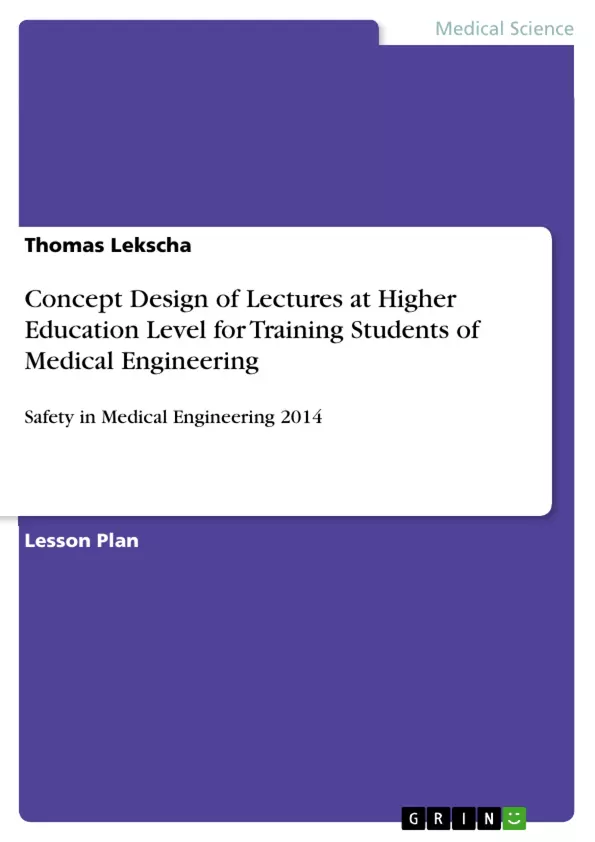This concept is intended to help develop a course of lectures specially aimed at training medical engineering students within the scope of Engineering or Bachelor studies at an institute of higher education. It should contain and illustrate basic aspects regarding the content of a course of lectures with its emphasis on “Safety in Medical Engineering”.
This instructional concept should also provide information and procedural instructions on drafting a lecture or lecture manuscript.
Inhaltsverzeichnis (Table of Contents)
- Introduction
- Safety in Medical Engineering
- Aims of the Course
- Legal Regulations
- Tasks of a Medical Engineer
- Mechanical Safety
- Electrical Safety
- Current, Voltage, Resistance
- Resistances in the Human Body
- Effects of Electricity on the Human Body
- Electrical Safety Precautions
- Power Supply Systems
- IEC Protection Classes
- Classification of Locations Used for Medical Purposes
- Currents and Leakage Currents in Medical Engineering
- Electrical Safety Measurements
- Safety-Related Controls
- Conclusion
Zielsetzung und Themenschwerpunkte (Objectives and Key Themes)
This lecture concept aims to provide a comprehensive overview of safety considerations within medical engineering, particularly focusing on electrical safety. It is designed for medical engineering students studying at the bachelor level. This course is designed to equip students with the knowledge and skills needed to handle and use medical devices responsibly, understand the risks involved, and implement preventive measures.
- Electrical safety in medical devices and equipment
- Legal regulations and standards relevant to medical devices
- Risk assessment and prevention in medical engineering
- Practical application of safety principles to real-world scenarios
- Development of solutions to address safety-related errors
Zusammenfassung der Kapitel (Chapter Summaries)
The introduction provides a brief overview of the lecture concept, highlighting its purpose and target audience. It emphasizes the importance of safety in medical engineering, covering various aspects such as electrical, mechanical, chemical, and hygienic safety.
The chapter on "Safety in Medical Engineering" delves into the various aspects of safety within the field, with a particular emphasis on electrical safety. It highlights the importance of understanding the specific risks associated with medical devices and the need for comprehensive safety measures.
The chapter on "Aims of the Course" outlines the objectives of the lecture course, which are to educate students on the responsible use of medical devices, including the special requirements for their development and construction. It stresses the importance of understanding potential risks, implementing preventive measures, and applying relevant legal regulations.
The chapter on "Main Legal Regulations" presents a selection of key legal regulations, directives, and standards applicable to the use of medical devices. This section provides students with an overview of the legal framework surrounding medical devices, ensuring they understand the requirements and obligations associated with their handling and use.
Schlüsselwörter (Keywords)
This lecture concept focuses on key areas within medical engineering, particularly electrical safety. It emphasizes the importance of understanding legal regulations, risk assessment, and practical applications of safety principles. Key terms include: medical devices, electrical safety, legal regulations, risk assessment, preventive measures, medical engineering, standards, IEC protection classes, and safety-related controls.
- Quote paper
- Dr. Thomas Lekscha (Author), 2014, Concept Design of Lectures at Higher Education Level for Training Students of Medical Engineering, Munich, GRIN Verlag, https://www.grin.com/document/278203



